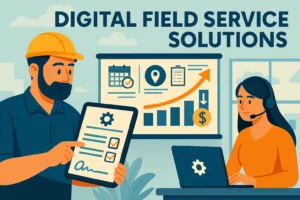What Is Employee Connectivity, and Why Does It Matter?
Employee connectivity is the ability of employees to stay connected to one another and to the company, no matter where they are or what roles they play. It’s not just about using messaging apps or having a company email—it’s about building a culture where communication, support, and shared goals are the norm.
Why does this matter? Because the way we work has changed. Remote and hybrid work are now common, and many teams are scattered across different locations and even time zones. Without strong employee connectivity, people can start feeling isolated, communication slows down, and productivity drops.
Think of employee connectivity as the “nervous system” of your company. When the connections are weak, information moves slowly, employees feel left out, and decisions take longer. When connectivity is strong, everything flows faster: collaboration improves, morale increases, and people feel like part of something bigger than just their daily tasks.
Benefits of Strong Employee Connectivity
Strong employee connectivity brings benefits that go beyond simple communication:
1. Better teamwork
When everyone has access to the same information and shares common goals, trust grows naturally. Employees are more willing to support each other, take initiative, and solve problems together.
2. Higher employee engagement
When people feel connected to their peers and to the company mission, they’re more engaged. Engaged employees are more productive and more creative and stay with the company longer, reducing turnover costs.
3. Faster decision-making
Markets change quickly, and teams need to respond just as fast. With strong employee connectivity, information flows smoothly, allowing companies to react to changes without unnecessary delays.
4. Improved productivity
Less time is wasted trying to figure out who knows what or how to reach the right person. Employees can focus on their tasks rather than chasing information.
Example: Imagine a busy restaurant with multiple shifts and dozens of employees. If servers, chefs, and managers can easily exchange information about rosters, menu changes, or special events, everything runs like clockwork: customers are happy, and employees feel less stressed.
Challenges in Employee Connectivity
While the idea is simple, building strong employee connectivity can be challenging:
Different time zones: Teams spread across regions often struggle to find overlapping hours to meet or collaborate.
Outdated tools: Relying on outdated communication systems or paper rosters slows everything down.
Lack of transparency: When information is hidden in isolated systems or available only to certain people, employees feel disconnected and out of the loop.
Cultural differences: In global teams, communication styles and expectations vary, which can create misunderstandings.
Understanding these challenges is the first step toward fixing them.
How Technology Transforms Employee Connectivity
Technology has completely changed how companies handle employee connectivity.
Shift scheduling tools (like Shifton) let employees check their rosters, swap shifts, and receive real-time notifications.
Company chat platforms and video meetings keep everyone connected, whether they’re in the office or on the road.
Cloud storage and collaborative documents remove barriers to data sharing and simplify teamwork.
Mobile apps ensure employees can access information anytime, anywhere—crucial for field workers and remote teams.
Modern technology doesn’t just connect employees; it creates a seamless experience that makes them feel like part of one cohesive team, even when they are physically apart.
Employee Connectivity in Remote and Hybrid Teams
Remote and hybrid work models add an extra layer of complexity.
There’s no casual “office talk” to quickly solve small problems.
New employees may feel isolated and disconnected from company culture.
Managers may struggle to track engagement and workload without direct face-to-face interaction.
The solution? Flexible digital tools and intentional communication practices. Shifton, for example, provides mobile access to work schedules, real-time updates, and internal messaging. This ensures employees stay informed, connected, and engaged regardless of location.
Best Practices for Improving Employee Connectivity
Here are proven ways to build and maintain employee connectivity:
1. Communicate transparently
Regular updates about company news, strategy changes, and team achievements help build trust and keep everyone aligned.
2. Provide easy communication channels
Employees need quick, accessible ways to reach colleagues and managers, whether through chat apps, mobile tools, or integrated platforms.
3. Encourage feedback
Open-door policies, one-on-one meetings, and anonymous surveys help employees feel heard and valued.
4. Use modern digital solutions
Platforms like Shifton make communication, shift planning, and task management simple and transparent, reducing misunderstandings and wasted time.
5. Train and support your team
Employees need to understand not just how to use new tools but why they matter. Training helps employees embrace technology and feel confident using it every day.
How Shifton Helps Boost Employee Connectivity
Shifton isn’t just another scheduling app—it’s a complete solution for building stronger employee connectivity:
Flexible scheduling: Employees can easily view their shifts, swap with others, and request changes without endless phone calls or emails.
Real-time notifications: No one misses updates—employees instantly know about schedule changes, new tasks, or company announcements.
Integrations: Shifton works seamlessly with HR and payroll systems, reducing duplicate work and ensuring smooth processes.
Mobile access: Employees can manage their rosters, track hours, and communicate directly from their smartphones.
The result? Less chaos, more clarity, and a stronger sense of connection across the team. Shifton helps businesses improve employee engagement, reduce scheduling stress, and create an environment where communication is effortless.
Conclusion
Employee connectivity isn’t just a buzzword—it’s a critical element of modern business success. Strong connections among employees improve productivity, reduce stress, and foster a positive company culture.
In an era where hybrid and remote work have become standard, investing in employee connectivity is an investment in your company’s future. Tools like Shifton make it easier to keep employees connected, engaged, and aligned with company goals, no matter where they are.
When employees feel supported and connected, they don’t just work harder—they work smarter and stay longer, helping your business grow and thrive.

 English (US)
English (US)  English (GB)
English (GB)  English (CA)
English (CA)  English (AU)
English (AU)  English (NZ)
English (NZ)  English (ZA)
English (ZA)  Español (ES)
Español (ES)  Español (MX)
Español (MX)  Español (AR)
Español (AR)  Português (BR)
Português (BR)  Português (PT)
Português (PT)  Deutsch (DE)
Deutsch (DE)  Deutsch (AT)
Deutsch (AT)  Français (FR)
Français (FR)  Français (BE)
Français (BE)  Français (CA)
Français (CA)  Italiano
Italiano  日本語
日本語  中文
中文  हिन्दी
हिन्दी  עברית
עברית  العربية
العربية  한국어
한국어  Nederlands
Nederlands  Polski
Polski  Türkçe
Türkçe  Українська
Українська  Русский
Русский  Magyar
Magyar  Română
Română  Čeština
Čeština  Български
Български  Ελληνικά
Ελληνικά  Svenska
Svenska  Dansk
Dansk  Norsk
Norsk  Suomi
Suomi  Bahasa
Bahasa  Tiếng Việt
Tiếng Việt  Tagalog
Tagalog  ไทย
ไทย  Latviešu
Latviešu  Lietuvių
Lietuvių  Eesti
Eesti  Slovenčina
Slovenčina  Slovenščina
Slovenščina  Hrvatski
Hrvatski  Македонски
Македонски  Қазақ
Қазақ  Azərbaycan
Azərbaycan  বাংলা
বাংলা 

